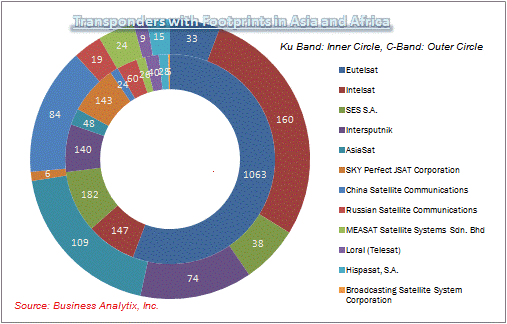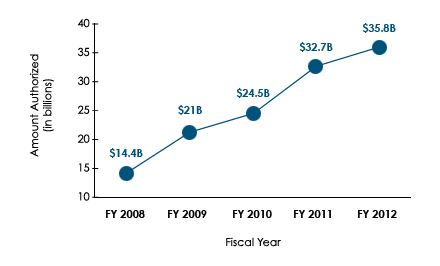Export Credit: Helping the Long Tail of the Satellite Industry
by Rajiv Hazaray and Carter Lawson
Princeton, NJ, March 5, 2013--The launch of the first commercial communications satellite (Intelsat1, nicknamed “Early Bird”) on 06 April 1965, the commercial satellite industry has seen declining technology risks but still remains fraught with many business risks. It is a capital-intensive industry with high barriers to entry. An aspiring satellite operator faces the difficult decision of investing hundreds of millions of dollars up to three years before the satellite takes its flight and stabilizes in its orbital slot. After a successful launch, the operator will need to recover his investment during next 15 years before the satellite consumes all the fuel onboard and starts its uncontrollable and destined wobble.
In today’s world, it is very difficult to predict where the technology will take us in five years. But, a satellite operator often makes a huge investment decision forecasting the cash flows over the time span of eighteen years. Once a satellite is launched, the operator can do preciously little but to hope that the earth does not tilt on its technology axis so much to render the expensive gadget in the sky obsolete.
Large investment, lack of agility, long investment horizon: these realities create a difficult scenario for a new industry entrant or even an existing entrant without a proven market demand that promises a quick break-even. Though it helps the established players maintain their lion’s pride, it is not good news for path breaking innovations or new entrants. It is also not an ideal situation for many of the technology vendors who would want to leverage their technology assets as much as possible to reduce costs and earn more revenue.
 The satellite industry is going through a major transformation. It is developing a significant “long tail” (see accompanying chart of transponders with footprints covering Asia and Africa) with increasing number of regional and niche players making an effort to make their mark. These new entrants, with substantial headroom for expansion in Latin America, Asia, and Africa; have access to profitable markets and can create viable business if they are successful in raising initial capital at low cost. This is where the role of export finance fits into the satellite ecosystem perfectly.
The satellite industry is going through a major transformation. It is developing a significant “long tail” (see accompanying chart of transponders with footprints covering Asia and Africa) with increasing number of regional and niche players making an effort to make their mark. These new entrants, with substantial headroom for expansion in Latin America, Asia, and Africa; have access to profitable markets and can create viable business if they are successful in raising initial capital at low cost. This is where the role of export finance fits into the satellite ecosystem perfectly.
Role of Export Credit Agencies in the Global Economy
Commercial bank lending supporting export transactions was among the list of the well-documented casualties of the Global Financial Crisis. In response to the drying up of the traditional credit, export credit agencies (“ECAs”) filled a critical void in trade and export finance. Historically, as lenders-of-last-resort, ECAs’ lending patterns have been counter-cyclical. As commercial banks retreat from lending, ECA activity grows. With the most recent crisis, this patter not only held out but was magnified. For example, in FY 2008, the Export-Import Bank of the United States (“Ex-Im Bank”) authorized financing of $14.48 billion. Compare this to the most recent fiscal year, 2012, where Ex-Im Bank authorizations of totaled $35.88billion and supported nearly $50 billion in exports.
Export Credit Agencies and Satellite Financing
Given that the construction, launch, and performance risk of placing a satellite in orbit, satellite owners historically have taken advantage of ECAs to finance satellite purchases and launch services. Not surprisingly, during the aftermath of the global financial meltdown in 2008, when the commercial banks had withdrawn from the market even cash-rich, low-debt operators sought financing from ECAs. But, even after the easing of the availability of the commercial credit, the uptick in ECA activity continues to be a boon; especially for the smaller, newer, and at times regional satellite providers to get financing at terms not available from private financiers. As the Federal Aviation Administration mentions in their report 2012 Commercial Space Transportation Forecasts, “most established companies with robust balance sheets are not experiencing problems securing debt, while those companies with more unpredictable business plans have less access to financing and often rely on project financing or export credit agency (ECA) backing.”
Not surprisingly, the export credit agencies of the United States and France are very active in the satellite sector.
Their activity is a reflection of the importance of the satellite manufacturing industry to the economy of each respective country.
In FY 2011, US Ex-Im Bank financed approximately $1.4 billion for the satellite industry. This amount accounted for roughly 11% of the long-term structured and project-finance transactions approved by Ex-Im Bank that year. Recent transactions financed by US Ex-Im Bank included:
· The export of three satellites and related equipment from Boeing Space and Intelligence Systems to the Mexican government for the MEXSAT regional mobile satellite system.
· The first financings of satellite exports from Lockheed Martin Space Systems Co. to NewSat Ltd. in Australia and the government of Vietnam.
France’s Compagnie Française d'Assurance pour le Commerce Extérieur (Coface) has provided significant financing support on behalf of Arianespace and [manufacturers?], among others. Some recent Coface transactions include:
· Trade receivables financing and management to many GSO satellite operators such as SES, Inmarsat, HISPASAT, Shin Satellite, Star One, Avanti, and Gazprom, as well as NGSO operators Globalstar and O3b Networks.
· Support for Hispasat and Newsat launch on the Arianespace rocket.
· Guarantees for the next generation Globalstar constellation of 48 satellites, at a time when it was critical for the very survival for the company.
· Buyer credit awarded to O3b Networks Ltd to facilitate the manufacture of the O3b Networks Ltd. gigabit speed satellites by Thales Alenia Space.
In recent years, with an objective of supporting its growing ambitions in the international satellite and launch industries, China too has wielded export credit to capture some market territories, especially in Asia and Africa. It extended preferential buyers credit of $200 million in for Nigeria’s first communications satellite.
The Opportunity
Increased availability of the export credit opens doors to multitudes of opportunities in this capital-intensive industry that would have been out-of-reach for many players without it. Recent Federal export policy reform in the commercial satellite arena would certainly stimulate the export activity from US. At the same time, China’s aggressive posture will fuel further competitive action and expand the export credit available to the new projects.
 These opportunities need not just be restricted to the manufacturers and buyers of the satellites, launch vehicles, and other space segment related assets but can well be tapped by the ground segment players.
These opportunities need not just be restricted to the manufacturers and buyers of the satellites, launch vehicles, and other space segment related assets but can well be tapped by the ground segment players.
Several emerging and frontier economies have growing economies and mounting ambitions in the space industry. Many of these economies are well suited for satellite services due to lack of terrestrial telecommunication infrastructure. There could be opportunities in developed countries, too. Several remote and rural consumers and enterprises can be well served using satellite technology, especially the third generation technology such as High Throughput Satellites. Next few decades, we will see rise of smaller niche and regional players with innovative technological solutions and
new business models thriving by the side of established big players.
Many Shades of Export Credit
Export Credit can be an extremely important resource for these new entrants. More common export credit options available to the operators are:
Loan Guarantees and Direct Loans: ECAs can assist purchasers of satellite-related goods and services by guaranteeing term financing from commercial banks or making direct loans. This program allows purchasers to obtain competitive term financing when such financing is otherwise not available, the interest rates are not competitive, or the term for repayment is insufficiently short.
Export Credit Insurance: As with direct and guaranteed loans, most ECAs offer credit insurance covering credit sales for payment terms of up to 5 years. This insurance is intended to both simplify and secure trade finance transactions.
However, what makes export credit more interesting is that each ECA has individually-tailored products and policies, and borrowers can often take advantage of more than one particular product, depending on the specifics of the transaction.
Best Yet to Come for the Satellite Industry
In our opinion, the current export credit volumes merely scratch the surface of the enormous probabilities that exist globally. The satellite industry is just entering the mainstream market and we expect to see the emergence of many new winners in the emerging reality. Quite a few of them will be greatly assisted by government-supported export credit.
----------------------------------------------
Rajiv Hazaray is the Principal, Business Analytix, Inc. (www.business-analytix.com) which serves leading satellite, telecom and technology companies as an management consultant. Carter Lawson is a Partner with McAllister & Quinn and had previously served as the Deputy General Counsel for the US Export-Import Bank. Rajiv and Carter, along with Mr. Stephen G. Tom, a satellite industry veteran; have formed Global Infrastructure Finance Advisors that specializes in arranging trade and project finance from export credit agencies (ECAs) and international financial institutions (IFIs) around the world. Read more at www.globalif.com.





